Interior decoration of houses from SIP panels. Construction of self-supporting insulated houses. Interior decoration
Among the inexpensive and popular technologies for the construction of cottages, frame houses from vulture panels stand out. By its place of origin, it was named "Canadian".
Sip panel is a multilayer material for mounting house walls on a finished frame. The base is two (OSB), between which the foam is laid. The whole system is glued with polyurethane glue.
This construction protects the dwelling from cold and heat. But outside walls consisting of OSB require protection from the harmful effects of moisture. In the article, we will consider how it comes from vulture panels.
Various materials are used for facing panels outside. The main ones are given below:
- artificial flexible stone;
Cladding a house with any material from the list allows you to get a good result. You should carefully study the technological features of facade finishing and choose the best option for yourself. So ?
Siding - has long been successfully used for finishing the facades of residential buildings from vulture panels
It does not require prior or plastering. Fastening of the panels is carried out on a pre-assembled metal or wooden frame.
The main advantages of the material:
- Siding is reliably protected from the harmful effects of moisture. Due to its structure, the material does not absorb water, reliably protecting the inner surface of the walls;
- Wide range of panel colors;
- Does not require additional processing after installation. The panels are produced ready-made. No painting or impregnation required
- High speed of installation of elements;
- Little weight. An important parameter, since the outer walls of low-rise residential buildings are not designed for the installation of heavy suspended structures.
- Does not collapse with seasonal fluctuations in the geometric dimensions of the facade. Frame houses from sip panels can slightly "expand and contract". Siding fixing allows you to neutralize these vibrations;
- Installation period not limited in time of the year. refers to the "dry" type of facade finish. Seasonal climatic changes do not affect the work process.
The main disadvantages of the material:
- Vinyl siding is poorly protected from mechanical deformation. Even a slight impact can lead to cracks or chips in the panel;
- Destroyed by ultraviolet rays from the sun.
Flexible stone
Modern finishing material for facades made of vulture panels. Combines aesthetic properties natural stone and the flexibility of plastic. It is made from a mixture of marble chips and epoxy resin.

It is glued to the facade with a special glue. The surface must be fairly flat. On sale there are additional elements for facing corners, gables, joints.
The main advantages of the material:
- Low water permeability. The finished facade does not absorb moisture from the environment;
- High vapor permeability. Despite its resistance to getting wet, the material drains condensate well from the inner surface of the walls;
- Light weight (3-5 kg \u200b\u200b/ m2);
- Does not emit harmful substances. The material is made from natural and organic ingredients;
- Affordable price.
Main cons:
- Cracking on the stone surface. There are many cheap and low-quality materials on the market. Their strength and reliability may not correspond to the normative indicators.
Wooden block house
Is a wooden panel convex on one side and flat on the other. Serves to imitate a log house. Each element has grooves and locks for reliable and quick attachment to the facade and to each other.
The main advantages of the material:
- Ecological cleanliness. It is made from natural wood.
- Strength. Qualitatively protects the vulture panel from the external environment;
- Attractive appearance. A house with such a facade will perfectly fit into a rural or forest landscape.
- Fast assembly. The material is designed for intuitive installation without the need for expensive specialized tools. Sheathing the facade will not be difficult even for an unprepared person.
The main disadvantages of the material:
- Low fire resistance. The facade, faced with wooden block house panels, does not withstand the effects of open fire poorly.
Plaster is a reliable and durable finishing material
Despite the onset of modern technologies, vulture panels continue to be a popular method.
The main advantages of the material
- Does not require preliminary surface preparation. The plaster mortar is applied directly to;
- Large selection of colors. Mineral plaster is presented in a wide range of shades;
- High vapor permeability. All moisture will condense on the outside of the facade and evaporate without harming the internal supporting structures;
- The ability to frequently change the exterior of a building by changing the color of the facade - it is still required to renew the paint, about once every five years.
The main disadvantages of the material:
- Cracking tendency. From cyclical temperature differences or non-compliance with the technology of work, cracking and partial falling off of the plaster layer is possible.
- Regular facade plaster requires painting, not less than 2 layers, with expensive paint.
More options for facing materials
Profiled metal sheet. It is rarely used for the installation of facades of residential buildings. It is used to decorate the facades of industrial buildings. The mounting technology is close to. The sheet is mounted on a galvanized metal frame.
Clinker tiles. ... It is widely used in cottage cladding. Exterior decoration of residential buildings made of vulture panels with this material is a rare phenomenon due to the discrepancy between the cost per square meter of wall and cladding.
You can simply - it will look like plaster, but due to the roughness of the surface, the uniqueness of the structure is ensured. It is desirable to paint, rather densely, in several layers.
Facades frame houses from oriented strand board have practically no restrictions on the finishing material. The main thing is to follow the instructions and not allow "amateur performance" during construction and installation work.
The modern construction market offers a variety of finishing materials that have taken a worthy niche for interior decoration. The decoration of houses from vulture panels can currently be carried out using any modern material.
In order to disassemble what material will be made of sip, you must initially know what kind of material it is and what it consists of.
Sip panels are a fairly durable building material that consists of three layers:
- The first is thick OSB sheets.
- The second is polystyrene or polyurethane foam.
- The third is a sheet of thick OSB.
Features and characteristics:
- This material is considered environmentally friendly and is able to withstand a variety of loads. Not only one-story, but also two-story buildings are erected from it.
- Because the facing of the foam is an OSB sheet, we can say: the surface of the material is even and does not require additional alignment. Also, houses of this type are not insulated, since the foam is a dense insulation and insulator.
Council. If you plan to spend time in a house made of vulture panels in the cold season, then you should take care of additional insulation, which is carried out outside using a similar material.
Construction finishes

These designs have practically no restrictions in the choice of finishing materials.
How is the interior decoration of houses made of vulture panels, what material is suitable:
- Decorative plaster.
- Plastic clapboard.
- Ceramic tiles.
- Wooden clapboard.
- Block house.
- Decorative panels.
- Natural and much more.
Note. All materials are practical and durable and are available for easy installation.
Decorative plaster in the decoration of the structure from vulture panels
Decorative plaster has been used for interior decoration for many years. It's pretty simple to work with her.
Room decoration with its help can be limited only by the imagination of the designer himself. She has a large selection colors and shades.
There are also inclusions of threads, crumbs natural stone, tissue harnesses and more.
Plaster has:
- Moisture resistance.
- Vapor permeability.
- Practicality.
- Durability.
- Exquisite appearance.
- Frost resistance.
- Wear resistance.
Note. It does not fade from the rays of the sun and does not deform from temperature extremes.
Today there are various types of this material that are widely used both in outdoor and in internal worksoh:
- Acrylic plaster (polymer) - has excellent properties and characteristics, has almost always a glossy surface.
- Mineral, which consists of sand and lime and does not cause any harm to human health, is used for interior work, as the surface is matte and quickly gets wet.
- Silicone plaster and silicate plaster, which are quite similar in their properties, and in most cases are used for outdoor work.
Finishing the vulture panels with decorative plaster should be carried out on a prepared surface.
Surface preparation for decorative plastering

It is impossible to apply such plaster to an ordinary concrete or wooden surface, since over time it can simply move away from the surface and begin to deform. Preparatory work consists in plastering such a surface, if such actions have not yet been carried out on it.
For this process you will need:
- Starting and finishing plaster.
- Capacity for mixing their solution.
- Construction mixer.
- Level.
- Special mesh for plastering.
- Plain pushpins or construction stapler.
- Sandpaper.
Stages of work:
- The whole process of work is easy and you can do it yourself very quickly.
- Initially, on the surface of the OSB sheets along the entire perimeter of the room, a grid is attached using a construction stapler or buttons for plastering the surface.
- After that, the starting plaster solution is mixed and applied to the surface in small layers. Before the next layer, the previous one must dry.
Then the starting layer is processed with sandpaper. - The finishing plaster is applied to the starting plaster. All actions are performed in the same way. With the help of a building level, the application of plaster is checked during the work.
Note. Only after the completion of all work with the use of ordinary plaster, you can start using decorative.
The process of applying decorative plaster to the plastered surface

Decorative plaster is sold only in a dry free-flowing state, and in order to give it the desired consistency, there is a special instruction on the package. Strictly along it, water is poured into the container and the powder is gradually poured into it, while stirring the composition.
Council.
To speed up such a solution preparation process, you need to use a construction mixer, with which the mixture will be a homogeneous mass. Also, do not mix a large amount of mortar at once, as the properties of the plaster will be lost over time.
Features of material application:
- To apply decorative plaster, you need two spatulas (1 - large, 2 - small), sandpaper (as a last resort, if there are too visible defects on the surface after applying the product).
- The level in such works can not be used, since the tool is applied in thin, almost translucent layers. With a large spatula, the solution is applied to the surface, and a small one is auxiliary and serves to remove excess solution from a large spatula.
Council.
When choosing decorative plaster, it is worth clarifying which shade it will have after drying. In some cases, its color may change depending on the number of layers applied.
Plastic lining in the decoration of houses from vulture panels

Plastic in any finishing works has been used for a long time and has gained its popularity due to its quality and properties.
Is he:
- Moisture resistant and resistant to temperature extremes, which makes it possible to use it in rooms with high humidity.
- Practical and does not absorb all kinds of dirt (its surface can be cleaned with a normal damp cloth).
- Durable and reliable, as it does not deform under heavy loads;
- does not fade in direct sunlight, which makes its appearance unchanged for a long time.
Material Features:
- A plastic lining is produced in strips, which have special locks at their ends. With their help, all the finishing elements are fastened.
The plastic has a very low weight, and for its installation it will not be necessary to reinforce the additional surface. - It is worth considering that the price of such, compared to others, is very low, which makes it even more in demand.
- As a rule, plastic is mounted on a special crate. But in the decoration of houses from vulture panels, such actions began to be carried out quite rarely.
They fix the material directly on the surface of the OSB sheets, which makes it possible to save space and time.
Council. It is not necessary to perform such actions, since the OSB sheet is made of wood (breathable material) and it is able to pass air. This cannot be said about plastic lining.
If it adheres tightly to such a surface, then over time, various fungal diseases can begin to form on it.
It is for this reason that it is best to build a wooden crate on the surface for installation plastic panels small size.
You can freely attach the material to it. The video shows the process of working with plastic clapboard.
Council. If the interior decoration of the house from sip is performed with plastic clapboard, then for its greater strength it is worth using a construction stapler on the top and bottom of the material, the staples of which will firmly fix the clapboard on the crate.
Ceramic Tile for Sip Panel Finishing

Interior decoration sip houses can be made with ceramic tiles. In most cases, it is used as a floor covering, for decoration of kitchen and sanitary areas.
Tile:
- Practical.
- Moisture resistant.
- Frost resistant.
- Does not absorb dirt.
- Easy to assemble.
These are not all the advantages of such a finishing material:
- The ceramics are durable and reliable. She is able to withstand significant loads.
- Tiles can have different designs, sizes and surfaces (glossy or matte, convex or concave, porous or embossed). You need to work with it carefully, since the tile itself is considered a fragile material.
- Tiling of sip panels will last a very long time, since the material does not fade in the sun and its average life is at least 20-30 years. It all depends on the quality of the ceramic tiles and how much the house shrinks.
The last indicator is required to be found only if the structure is made of brick or other stone. Houses made of vulture panels practically do not shrink.
Installation of ceramic tiles on the surface of vulture panels
Interior decoration of a sip house using ceramic tiles begins with preparatory work on the surface. Since the OSB sheets are even, it remains only to prime them and allow the product to be absorbed well.
Used for installation:
- Special glue.
- Putty knife.
- Cross-shaped beacons.
- Level.
- Decorative putty.
Council. In such works, you should not use cement mortar instead of special glue, since a strong bond with cement will not be provided on the surface of OSB sheets.
Glue is applied to both surfaces:
- OSB sheet.
- The back of the tile.
These actions are performed using a spatula. Cross-shaped beacons provide uniform distance.
Upon completion of the work, the seams are processed with decorative putty of the desired shade.
The construction of frame houses from sandwich panels, consisting of OSB boards with a layer of insulation, has long gained wide popularity. Such houses are built quickly, do not need additional insulation, do not require a technological break to shrink before finishing.
On the contrary, SIP panels are cladding as quickly as possible so that their surface does not suffer from weather conditions. What materials are used for the exterior and interior decoration of these houses?
Despite the fact that OSB boards, which are the basis for SIP panels, are considered a waterproof material, it is better not to tighten them with finishing for the following reasons:
- Over time, panels made on the basis of wood chips begin to darken from exposure to sunlight, which does not affect their appearance in the best way. And if you leave them unprotected for several years, then constant contact with moisture will begin to act destructively on them;
- The cladding provides additional sound insulation and protects the interior from overheating. Finishing with an air gap between the cladding and the walls is especially effective in this regard;
- The surface of this wall material is not attractive enough to leave it exposed. The cladding gives a finished look to the entire structure, both inside and out.
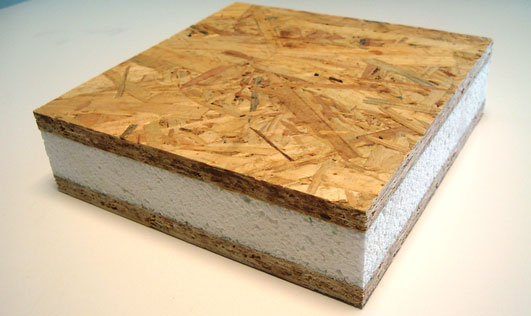
What are good about such houses is the exceptional simplicity of any type of decoration. Almost perfectly flat walls do not require leveling, which greatly simplifies the installation of cladding materials and reduces the time spent on work.
Choice of materials
In addition to such material characteristics as its service life, price, appearance, fire safety, etc., the choice depends on the operating conditions. Simply put, on what kind of walls you are going to finish - internal or external.
For facade cladding
The indisputable advantage of houses built from SIP panels is unlimited choice. You can use any finish, from plaster to modern composite panels, focusing only on your taste and financial capabilities.
Let's dwell on the most popular options:
- Plaster. This method is rarely used to beautify the facades of such houses, since it is simply not economically viable. High-quality plaster is expensive, as are the work on its application, and it is difficult to do them with your own hands.
Council. If you nevertheless chose this type of exterior decoration, you must strictly follow the technological sequence of work. They consist of the following stages: priming the surface with a composition with antiseptic additives, installing a reinforcing fiberglass mesh, basic surface plastering, applying decorative flexible plaster.
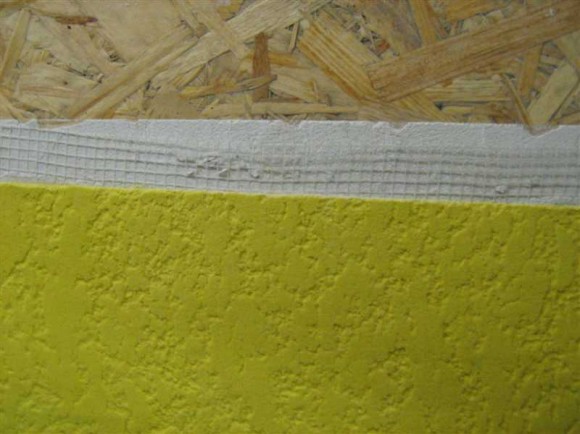
- from SIP panels with siding. Any type of siding is suitable for creating a facade - vinyl, metal, fiber cement, basement. Since the base is flat, it will be very easy to mount the frame to fix it.
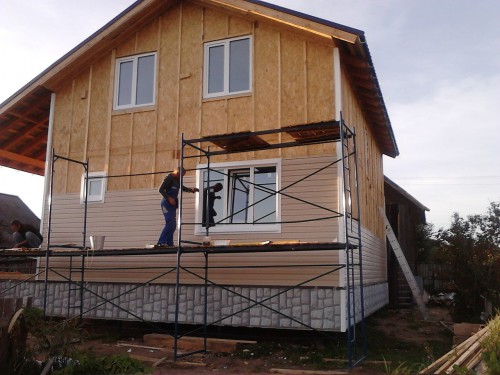
- Polymeric materials, which imitate these materials in a very natural way, are also quite often used to decorate such facades, allowing them to be transformed beyond recognition. Compared to cladding with real bricks and stones, it is cheaper and faster.
- Transform frame house in stone it is possible with the help of panels made of cement-sand mixture with various additives. It is very difficult to distinguish them from natural stone even on closer inspection.
Note. Cement panels are heavy, so the foundation must be strong enough to support the additional load.
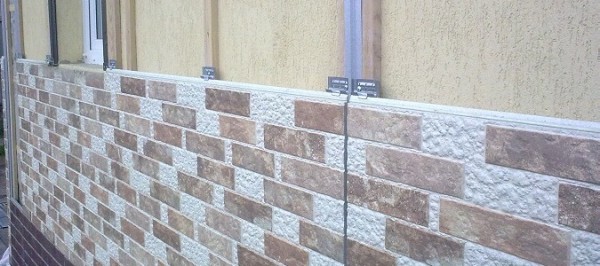
- Facing with clinker tiles and artificial stone will allow you to create a strong, reliable and durable coating, but it will be very expensive, since a huge part of the cost is surface preparation - reinforcement and basic plaster with special compounds.
- Composite sandwich panels for finishing such houses are used, if desired, to provide the building with more powerful protection against freezing in winter and overheating in summer.
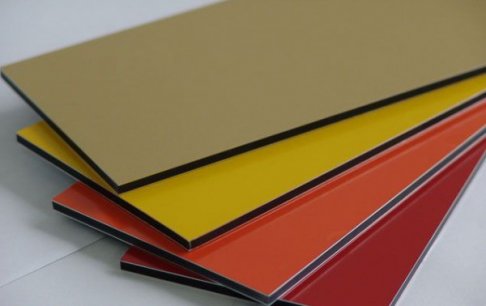
In addition to these, there are many other facade materials that can be used to revet SIP panels and cladding with any of them will cause much less difficulty than when decorating brick, panel or log houses.
For interior decoration
In heated rooms with a stable temperature and humidity regime, there is no need to protect the walls from freezing or exposure to snow and rain. The aesthetic side of the issue is more important here.
And there are people who are quite satisfied with how the walls look without decoration at all.
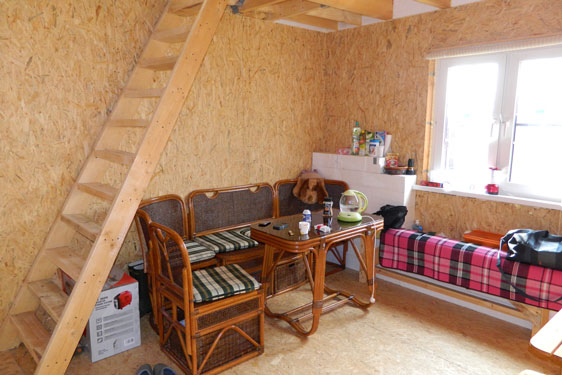
Since the walls are very smooth, their main task becomes design decoration... And here, too, all known finishing methods are suitable.
- Putty. It is necessary if you are going to paint the walls, since without preliminary preparation, the paint compositions are not able to level the rough surface of the plates, even after several layers of primer. Before puttying, the joints between the panels are sealed with masking tape.
Surface preparation instructions must be followed exactly:
- In the same way, the walls are prepared for wallpapering.
- There is also a radically different way - instead of putty, the walls are sheathed with plasterboard or LSU, which is screwed directly to the base, without a frame. Further, any options are possible decorative finishing from painting to tiling with appropriate surface preparation.
Note. Plasterboard cladding improves heat and sound insulation, and also reduces the degree of fire hazard of the building.
Of course, in our case, such finishing methods as cladding with plastic or MDF panels, as well as other similar materials, are also possible. Watching the video, you will see how easy it is to do this work.
Conclusion
Many modern developers as the main building material sandwich panels based on oriented strand boards are chosen for walls. This is due to both the high heat-saving qualities of the material and the ability to build a house with minimal costs and in a short time.
Last but not least, options for future finishes are also being considered, and in this regard, this material is out of competition, since it is possible to veneer SIP panels with anything, without waiting for the building to shrink.
2042 0 0
Home decoration from SIP panels: undeniable convenience in work
Panel houses are attractive both from the point of view of the speed of construction and the convenience of finishing. Neat "from head to toe" houses with barely visible joints between panels in most cases do not require preparatory work. And, most importantly, there are no restrictions in the choice of facing materials, which allows you to implement the most daring design decisions.
Nothing needs to be done just to work
Horizontal, vertical planes initially have a corresponding ideal position, which is the essence of panel construction - tile to tile and the house is ready. Consequently, both the inner and outer surfaces of the house are flat, ready for any finishing with any materials.

Facing SIP panels is much easier than finishing a facade of brick, stone, boards or timber for 3 objective reasons:
- walls made of structurally insulating panels do not need - beacons, screed;
- much less plaster is consumed on a flat surface;
- time is spent directly on working with finishing materials.
Outdoor plans
It is unlikely that anyone would dare to leave the outer walls of the house made of three-layer panels in their natural form, open to all the elements, the aesthetic side may also be lame - the house seems to be made of cardboard. The question of how to decorate the outside of the wall is usually solved according to a familiar scenario using well-known materials:
- basement and wall siding made of vinyl, metal;

- block house;
- natural and artificial stone (it is lighter than the first, cheaper and no less durable);
- decorative plaster - silicone, polymer, acrylic, mineral;
- clinker bricks;
- lining;
- tiles;

- fiber cement panels - an analogue of siding, but with the addition of high grade concrete; have a wide color scheme with imitation of stone / wood;
- corrugated board (metal sheet with a polymer coating), it is usually used for outbuildings, garages.

Any external cladding serves specific purposes:
- to give the structure an aesthetically complete look;
- create an additional protective layer from natural factors, fire;
- satisfy the homeowner's ambitions.

The relatively low price of a house built using Canadian technology and fantastically short construction times save money and time for its detailed cladding. It can only be brick, plaster, siding or an original combination of timber-wild stone, plaster-tile.
Do not be intimidated by the large weight of some facing materials, the walls will withstand them... Tests have shown that structural insulating panels can withstand longitudinal loads of more than 10 t / linear. m and more than 2 tons in the transverse direction.

Plinth facing with natural marble, wild stone or imitating natural surfaces will give the house a special charm. In any case, an unsightly outdoor panel base can turn into a fabulous log tower, a prim English mansion or a sturdy hut a la country.

External cladding installation technology
As already mentioned, the facing work is carried out according to the traditional scenario with pleasant nuances, which are "presented" by smooth walls:
- the lathing for siding / lining is attached to the wall without troublesome alignment, with self-tapping screws;
- installation of a moisture-vapor-proof layer provides for a careful approach to ventilation of the room inside;
- plastering is carried out as standard: reinforcing mesh-primer-finishing layer of plaster.

Do not ignore the value of the building level, especially at the stage of installing siding / block house, etc. Each fixed section is checked horizontally.
There are no undercurrents, fatal secrets in installation technologies, except for one advantage, moreover, explicit and mentioned more than once - smooth walls. You can appreciate such a gift of fate only by directly working with it; finishing the facade of a house from SIP panels is an indescribable pleasure, according to eyewitnesses.
Inside view
The surface of self-supporting insulated wire panels in bare form can itself serve as a design solution. On the one hand, chaotic strokes of pressed wooden fragments will surely evoke positive emotions among adherents of abstract painting and maximum closeness to nature.

One cannot but agree with this - natural fabrics, homespun paths, forged design elements will look good in a “spotted” wooden atmosphere. On the other hand, the monotonous variegation inside the room, so to speak, visually “blurs” the three-dimensional space - corners, joints of the floor and walls disappear.
In such an environment, older people can feel extremely insecure physically and mentally. For comparison, we can give an example with an unsuccessful convex / curved pattern of paving slabs, on which it is sometimes scary to step.

Painting
Run your hand over the SIP panel, and you will feel all the irregularities - the smallest depressions and bulges formed by compressed wooden fragments. It would be very reckless to paint such a wall / ceiling from a plaque (even in several layers) - paint, especially glossy, will only emphasize irregularities.

A perfectly flat surface can be achieved in two ways:
- sheathe the walls with plasterboard / plasterboard;
- plaster.
To avoid cracking, the joints between the slabs are always covered with a reinforcing mesh.
- wallpaper - fiberglass, cork, bamboo, laminated;
- porcelain stoneware tiles.
The facade for painting is only previously plastered on a reinforcing mesh, and the plaster mixture can already be tinted. When painting with a roller, the supply of paint should be double, because you will have to paint at least twice with a preliminary complete drying of each layer.

Magnesite magic wand
Magnesite plates with a thickness of 8–12 mm and dimensions from 920x1840 to 1200x2400 mm can serve as a kind of facing material. Created on the basis of magnesium oxide and chloride, they represent natural material and were originally intended as protection against adverse factors:
- high humidity;
- fire hazard;
- sudden changes in temperature;
- noise.

Plates can be as independent finishing material, and act as a base for painting. Such interior decoration of SIP panels with magnesite slabs will be appropriate outside or in rooms with a certain specificity:
- pantry;
- garage;
- boiler room;
- pool / sauna;
- kitchen.

To enhance the water-repellent properties, magnesite slabs are treated with their own hands with water-repellent impregnation.
Top bottom
The flat surface of the ceilings allows you to embody any fantasy in the range of luxury - economy option:
- sophisticated multi-level plasterboard structures - diagonal, frame, zonal, using a variety of lighting options;
- stretch ceilings PVC / fabric;
- expanded polystyrene plates.

The floors made of SIP panels will never be cold thanks to the expanded polystyrene lining, so their interior does not require a heat-insulating layer, you can immediately install:
- carpet;
- laminate;
- parquet;
- linoleum.

In damp rooms, it is advisable to make a cement / polymer screed on which to lay tiles or give yourself a self-leveling floor.
Summarizing
The peculiarity of a house made of SIP panels can be understood by touching a flat warm wall with your hand. "Fresh" it looks almost frivolous, in a dollhouse and the issue of finishing is not even discussed - it follows on without fail. The huge margin of safety of the panels and compatibility with any facing material allows you to design a home for every taste.
Reliable information on the interior decoration of a vulture at home can be obtained from the video in this article from a direct participant in the process.
In the comments to the article, you can express your opinion, ask questions and, of course, share your invaluable experience in finishing work.
October 4, 2016If you want to express gratitude, add clarification or objection, ask the author something - add a comment or say thank you!
Siding
The most budgetary option for exterior decoration of self-supporting insulated wire at home is siding cladding. It is lightweight, quick to install, easy to maintain, and does not corrode. In addition, the widest range of colors is offered. It is not surprising that siding is considered the most popular material for external cladding houses.
Lining and block house
These materials will help give the house the appearance of a real log house. It will be indistinguishable from a house made of logs, while retaining all the advantages of SIP panels.
Plastering and painting
SIP panels can be simply plastered, giving the house a southern flavor. You can choose absolutely any color or create panels on the walls, making your home original. Mineral plaster is a non-combustible and frost-resistant material. It enhances the protective properties of SIP panels.
Thermal panels
Such exterior decoration it is created from plates similar in technology to creating SIP panels. They also consist of layers, but they are not intended for construction, but for decoration. Expanded polystyrene or polystyrene is used as a heater. Externally, a wall lined with such panels can look like brickwork or have any other appearance.
Ventilated facade
These are also panels for exterior decoration, but they are single-layer, made of plastic, porcelain stoneware, metal or fiber cement. Outwardly, they resemble large tiles.
Artificial and natural stone
Exterior and interior decoration of a house from SIP panels with a stone can turn a pre-fabricated house into a real fortress. In wall cladding, stone is usually combined with other finishing materials.
Brick
The most expensive exterior finish is with decorative bricks. In fact, next to the wall of vulture panels is laid out brick wall... It's costly and often makes no sense. Instead of real facing bricks, you can use wall or clinker tiles.



